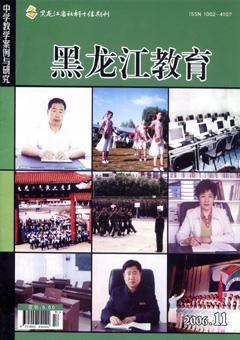Unit 11 What time do you go to school?
賈春紅
[選自人教版《英語》(新目標)七年級上冊第十一單元Section B(1a~2c).]
一、教材分析
本單元的核心內容是圍繞“What time /When do you...?” “What time/When does he ...?”等問題談論自己的日常生活及日常作息習慣。通過本課的學習,讓學生掌握不同時間段的表達法,學會合理安排好自己的日常活動,并且能夠了解和轉述他人的日常生活安排,提高學生的語言交際能力和表演能力。
二、教學目標
1.知識目標:(1)學習不同時間段的表達法,并會用when和what time詢問時間。(2)學會用頻度副詞談論自己的日常生活和日常作息習慣。
2.能力目標:學會合理安排自己的學習和課外活動。
3.情感目標:通過學習和同學的交流,科學地制定出適合自己的學習計劃或一天的活動安排,使自己養成良好的作息習慣,懂得珍惜時間,并能夠做到了解和尊重他人的生活習慣。
三、教學重點與難點
1.重點:用頻度副詞談論日常作息時間,并會詢問時間和表達時間。
2.難點:合理安排自己的作息時間,并且轉述他人的日常生活安排。
四、教學思路
在本課的教學中,我采用任務型語言教學模式,讓學生在教師的指導下,通過感知、體驗、參與和合作等方式來實現教學目標。在學習的過程中,強化學生的時間觀念,使學生形成積極的學習態度,以促進學生語言運用能力的提高。
五、課堂實錄
Step1:Review the drills.
T: Work in pairs with “What time is it ?”and “what do you usually do at this time?(利用倆倆對話形式來復習學過的句型。)
S1: What time is it ?
S2: Its six fifteen pm.
S1: What do you usually do at this time?
S2: I usually eat dinner with my family.
Step 2: Present the new phrases.
T:I think S1 usually eats dinner with his family at six fifteen pm.“Six fifteen pm”means six fifteen in the evening. Read after me “in the evening”.(利用多媒體呈現“in the evening”圖片。)
Ss: In the evening.
T: When do you get up? Can you tell me ?
S3: I get up at six am.
T: Yeah, she gets up at six am. “Six am” means six in the morning, right? Read after me “in the morning”.(利用多媒體呈現 “in the morning”的圖片。)
Ss: In the morning.
T: When do you play football?
S4: I usually play football at four pm.
T: I think it is in the afternoon. Read after me “in the afternoon”. (利用多媒體呈現 “in the afternoon”的圖片。)
Ss: In the afternoon.
T: Do you know the parts of the day ? Letssay them together in order. “In the morning, at noon, in the afternoon, in the evening ,at night ,at midnight and so on .” Remember: “At noon” is twelve oclock in the middle of the day. “At night is after six oclock in the afternoon. “At midnight ” is at twelve oclock in the night .(教師解釋詞組的區別,學生記筆記。)
T:The boy does his homework in the afternoon. When do you usually do your homework?(利用多媒體呈現“do ones homework”的圖片。)
S5: I usually do my homework in the evening.
T: What about you?
S6: In the afternoon.
T: Read after me “do homework” and “do ones homework”.
Ss: ...
T: I hope you do your homework carefully every day.When do you usually go home?
(利用多媒體呈現“go home”圖片。)
S7: I usually go home in the evening.
T: Oh, metoo. I hope all the students in our class go home on time every day.
Step 3:Practice.
Model: T: When do people usually eat
dinner?
T:People usually eat dinner in the evening.(教師自問自答。)
T:Please work in pairs like this.(教師走向學生中間巡視,必要時給予指導。)And let some groups act it out in front.
T:Look at the pictures and finish them.
(多媒體出示Section B中1a的圖片,學生邊看邊回答。)
Step 4:Listening.
T: Look at the picture, Do you want to know what they are talking about? Lets listen and finish 2a and 2b. (放3遍錄音,學生邊聽邊完成,然后核對答案。)
T: Now please work in pairs about Toms day. Pay attention to the third person singular form, here “around” means about.
S: Tom usually gets up...(找幾名學生描述Tom的日常作息時間與活動。)
Step5:Practice.
T: Now, please work in group of four and find out your classmatesfamily members or his/her friendsdaily life,please fill in the chart. After that, I will ask anyone of each group to report.[學生展開活動,4人一組,邊問邊填表格(表格略),然后找4組學生進行匯報。]
Step 6:Homework.
1.Winter holiday is coming, how will you spend your holiday? Please make a reasonable timetable for you.
2.Make a survey about your favorite movie stars daily life.
(作者單位:海林市林業局第2中學)
編輯/于赫
E-mail:hehe625@126.com

